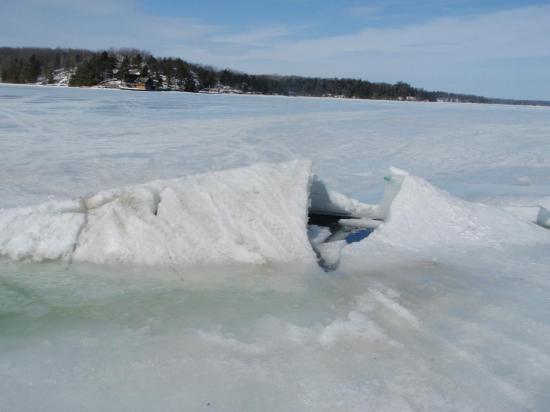Pressure Cracks Are Alive… Treat Them with Respect!

Other than some of the smaller Canadian Shield lakes that I love to fish in northern Ontario, the vast majority of larger lakes experience pressure cracks every winter. My home lake of Simcoe, just north of Toronto is notorious for developing some of the most incredible pressure cracks in the province. They can run parallel to shore, from point to point or out in the middle of nowhere – but they all have several commonalities that are worth noting:
- They are all alive! Ice is like a living thing – continually expanding and retracting during the course of the winter. Some days the two massive sheets can be tight, others they’re apart
- Periods of stable, below zero temps typically see little ‘growth’ in terms of the two ice sheets being shot up in the air to form ridges over a metre high, or the two sheets breaking apart with open water in between. The latter two scenarios are very common when temperatures fluctuate.
- Pressure cracks on big lakes can be many miles long and can consist of varying degrees of risk from one end to the other
- Some cracks will offer zero chance of safe crossing … while others narrow down and the two sheets meet, allowing for cautious approach and crossing
- Always approach all pressure cracks with care and respect … even small cracks near shore that are less than an inch wide in the morning can open up and barely be crossable by late afternoon. This typically happens during the late ice period, but with crazy winters like we’re having in 2016 … could occur any time
- Look for areas where others have crossed … you may have to travel well out of your way, but is something to be expected and accounted for
- When travelling by snowmobile, examine the crossing area on foot first. Pinpoint exact crossing lanes to fellow ice anglers and discuss potential hazards. Such as open water or ice blocks protruding beneath snow cover. The latter can be especially dangerous if not seen and can throw a sledder from the snowmobile
- You may wish to have a safety person designated on foot near the pressure crack to signal others in your group to cross
- Cross at moderate and steady speed – not too fast to cause waves to bounce up onto the hidden ice sheet underneath, but not too slow to bog down either
- With an ATV, you need to be extra cautious. A serious hazard can occur if the front wheels of your quad break thru. Long thick boards at least a foot wide are often used to cross minor cracks with ATV’s safely, but if cracks open more than even a few short inches or there’s week ice on either side- ATV’s should stay clear.
- With all pressure cracks you may need to accept that no safe place to cross exists other than on or right near shore. It can be a tough pill to swallow- but is what it is!
- Choose access locations that minimize pressure crack crossings all together whenever possible
Be prepared
- Carry your fully charged cell phone in a zip lock bag in an inside pocket
- One person in your group should carry a small shovel to check what’s beneath the cover of snow near a spot on the ice you want to cross. HT makes a nice little two piece model with an extra-large handle that you can easily fit your big mitt thru
- Wear your HT Retractable ice cleats at all times. Think of them like wearing a seatbelt- you hope you never have to count on them to save your life, but know they can if an accident occurs
- Consider wearing a floatation suit
- At least one person in your group should have a rope or one of HT’s wonderful new Rescue Throw Bags. Again, its something you hope you’ll never have to use but can be a lifesaver in an emergency
Throughout most of the ice belt here in southern and central Ontario the winter of 2016 has been one of the warmest in recent memory. Ice conditions can be fine on some lakes and non-existent on others. The majority are somewhere in between … with hazards like pressure cracks part of the deal anglers have to contend with. This winter treat those living pressure cracks with respect and pay special attention to safety to enjoy many more ice fishing seasons in the future!






